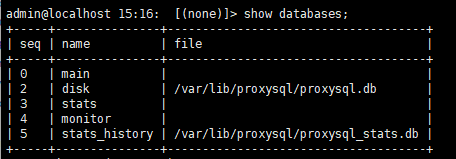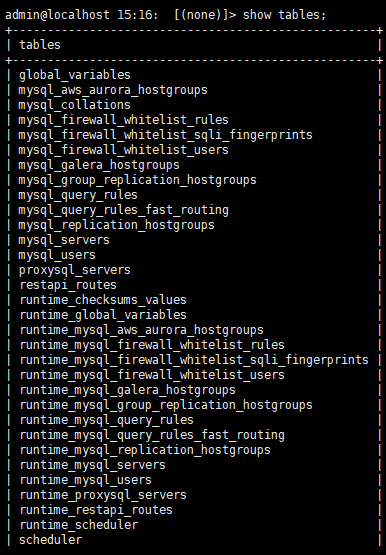mysql8.0 MGR + proxysql 部署
1. proxysql 作用以及架构
1.连接池功能 2. 读写分离(端口号, 用户, 正则, 某个sql) 3. 缓存功能 4. sql改写 5. 监控诊断系统 6. sql防火墙 7. sql审计 && query log (proxysql 2.5)
proxy安装:
配置yum源:
cat <<EOF | tee /etc/yum.repos.d/proxysql.repo [proxysql_repo] name= ProxySQL YUM repository baseurl=https://repo.proxysql.com/ProxySQL/proxysql-2.1.x/centos/\$releasever gpgcheck=1 gpgkey=https://repo.proxysql.com/ProxySQL/repo_pub_key EOF
安装proxysql
yum -y install proxysql 配置文件在 : /etc/proxysql.conf 启动/关闭 proxysql service proxysql start service proxysql stop 查看安装版本 proxysql --version proxysql 需要的监听端口 6032 管理端口 6033 对外服务端口 默认管理用户名密码: admin/admin
登陆proxysql
mysql -u admin -padmin -h 127.0.0.1 -P 6032
启动proxysql
systemctl start proxysql
systemctl enable proxysql
proxysql 重要概念:
配置文件: proxysql中的配置文件可以动态的更改生效 # 提供正在运行的程序应用 1. runtime #提供管理者修改 2. memory #持久化存储, 下次重启后还可以生效 3. disk(sqlite, configle) [1] LOAD <item> FROM MEMORY/LOAD <item> TO RUNTIME 将配置项从内存数据库加载到运行时数据结构 [2] SAVE <item> TO MEMORY/SAVE <item> FROM RUNTIME 将配置项从运行时保存到内存数据库中 [3] LOAD <item> TO MEMORY/LOAD <item> FROM DISK 将持久性配置项目从磁盘数据库加载到内存数据库 [4] SAVE <item> FROM MEMORY/SAVE <item> TO DISK 将配置项从内存数据库保存到磁盘数据库 [5] LOAD <item> FROM CONFIG 将配置项从配置文件加载到内存数据库中 重要说明:在将更改加载到RUNTIME之前,它们不会被激活,并且未保存到DISK的任何更改在ProxySQL重新启动后将不可用。
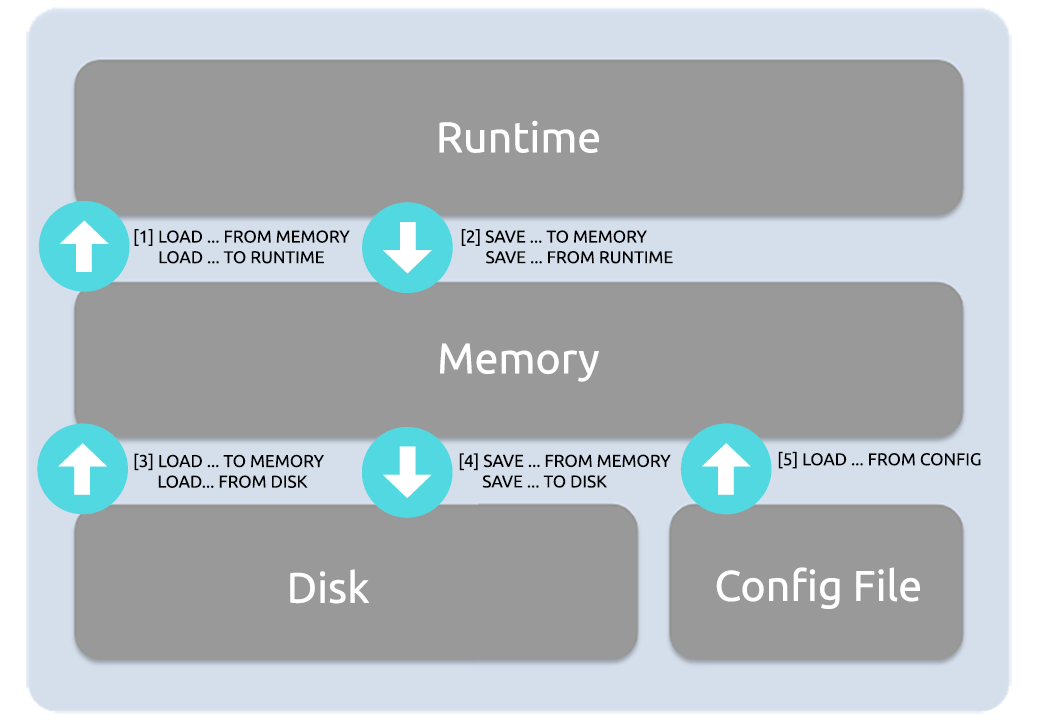
# Active current in-memory MySQL User configuration LOAD MYSQL USERS TO RUNTIME; # Save the current in-memory MySQL User configuration to disk SAVE MYSQL USERS TO DISK; # Active current in-memory MySQL Server and Replication Hostgroup configuration LOAD MYSQL SERVERS TO RUNTIME; # Save the current in-memory MySQL Server and Replication Hostgroup configuration to disk SAVE MYSQL SERVERS TO DISK; # Active current in-memory MySQL Query Rule configuration LOAD MYSQL QUERY RULES TO RUNTIME; # Save the current in-memory MySQL Query Rule configuration to disk SAVE MYSQL QUERY RULES TO DISK; # Active current in-memory MySQL Variable configuration LOAD MYSQL VARIABLES TO RUNTIME; # Save the current in-memory MySQL Variable configuration to disk SAVE MYSQL VARIABLES TO DISK; # Active current in-memory ProxySQL Admin Variable configuration LOAD ADMIN VARIABLES TO RUNTIME; # Save the current in-memory ProxySQL Admin Variable configuration to disk SAVE ADMIN VARIABLES TO DISK;
Hg-> HostGroupp 机器分组: writer_hg(read_only=0), read_hg(read_only=1), max_writers Query digest 每一个类型的Query形成一个唯一的Hash Code Query Rule 通过正则或者 Hash Code 指定查询到不同的Hg proxysql 用户 链接proxysql 的用户(frontend,backup同时为1)
核心表
1. mysql_users 2. mysql_servers 3. mysql_replication_hostgroups 4. mysql_query_rules
实现 一主两从的节点读写分离
| 角色 | ip | port | database | 数据库状态 | user/password |
| master | 172.16.230.53 | 3306 | t1 | read_only=0 | fengjian/123456 |
| slave1 | 172.16.230.51 | 3306 | t1 | read_only=1 | fengjian/123456 |
| slave2 | 172.16.230.52 | 3306 | t1 | read_only=1 | fengjian/123456 |
| proxy | 172.16.230.54 |
6032 6033 |
t1 | fengjian/123456 |
启动proxysql并且登陆
systemctl start proxysql
systemctl enable proxysql
mysql -u admin -padmin -h 127.0.0.1 -P 6032
PXC集群使用的 mysql_galera_hostgroups
MGR集群使用的 mysql_group_replication_hostgroups
配置复制(半同步) mysql_replication_hosgroups
注意: 账号必须用 with mysql_native_password 认证方式.
登陆从库 设置数据库为可读状态:
# 登陆到172.16.230.151 mysql从库 [root@mysql1 ~]# mysql -u root -p # 设置为可读 root@localhost 15:49: [(none)]> set global read_only=1; root@localhost 15:49: [(none)]> show global variables like '%read_only%'; +-----------------------+-------+ | Variable_name | Value | +-----------------------+-------+ | innodb_read_only | OFF | | read_only | ON | # 登陆到172.16.230.152 mysql从库 [root@mysql1 ~]# mysql -u root -p # 设置为可读 root@localhost 15:49: [(none)]> set global read_only=1; root@localhost 15:49: [(none)]> show global variables like '%read_only%'; +-----------------------+-------+ | Variable_name | Value | +-----------------------+-------+ | innodb_read_only | OFF | | read_only | ON |
创建monitor用户名, 用于监控
admin@localhost 15:18: [(none)]> select * from global_variables; | mysql-monitor_username | monitor | | mysql-monitor_password | monitor |
create user 'monitor'@'%' identified with mysql_native_password by 'monitor';
grant replication client on *.* to 'monitor'@'%';
1. 创建分组
admin@localhost 16:25: [(none)]> insert into mysql_replication_hostgroups(writer_hostgroup,reader_hostgroup,comment) values(100,101,'senyint3306')

2. 添加数据库到server中
admin@localhost 16:27: [(none)]> show create table mysql_servers; | mysql_servers | CREATE TABLE mysql_servers ( hostgroup_id INT CHECK (hostgroup_id>=0) NOT NULL DEFAULT 0, hostname VARCHAR NOT NULL, port INT CHECK (port >= 0 AND port <= 65535) NOT NULL DEFAULT 3306, gtid_port INT CHECK ((gtid_port <> port OR gtid_port=0) AND gtid_port >= 0 AND gtid_port <= 65535) NOT NULL DEFAULT 0, status VARCHAR CHECK (UPPER(status) IN ('ONLINE','SHUNNED','OFFLINE_SOFT', 'OFFLINE_HARD')) NOT NULL DEFAULT 'ONLINE', weight INT CHECK (weight >= 0 AND weight <=10000000) NOT NULL DEFAULT 1, compression INT CHECK (compression IN(0,1)) NOT NULL DEFAULT 0, max_connections INT CHECK (max_connections >=0) NOT NULL DEFAULT 1000, max_replication_lag INT CHECK (max_replication_lag >= 0 AND max_replication_lag <= 126144000) NOT NULL DEFAULT 0, use_ssl INT CHECK (use_ssl IN(0,1)) NOT NULL DEFAULT 0, max_latency_ms INT UNSIGNED CHECK (max_latency_ms>=0) NOT NULL DEFAULT 0, comment VARCHAR NOT NULL DEFAULT '', PRIMARY KEY (hostgroup_id, hostname, port) ) | admin@localhost 16:27: [(none)]> insert into mysql_servers(hostgroup_id,hostname,port,max_connections) values(100,'172.16.230.53',3306,200); Query OK, 1 row affected (0.00 sec) admin@localhost 16:29: [(none)]> insert into mysql_servers(hostgroup_id,hostname,port,max_connections) values(101,'172.16.230.51',3306,200); Query OK, 1 row affected (0.00 sec) admin@localhost 16:29: [(none)]> insert into mysql_servers(hostgroup_id,hostname,port,max_connections) values(101,'172.16.230.52',3306,200); Query OK, 1 row affected (0.00 sec)

3. 加载到runtime 并保存
load mysql servers to runtime;
save mysql servers to disk;
4. 配置账号:
admin@localhost 16:32: [(none)]> show create table mysql_users; | mysql_users | CREATE TABLE mysql_users ( username VARCHAR NOT NULL, password VARCHAR, active INT CHECK (active IN (0,1)) NOT NULL DEFAULT 1, use_ssl INT CHECK (use_ssl IN (0,1)) NOT NULL DEFAULT 0, default_hostgroup INT NOT NULL DEFAULT 0, default_schema VARCHAR, schema_locked INT CHECK (schema_locked IN (0,1)) NOT NULL DEFAULT 0, transaction_persistent INT CHECK (transaction_persistent IN (0,1)) NOT NULL DEFAULT 1, fast_forward INT CHECK (fast_forward IN (0,1)) NOT NULL DEFAULT 0, backend INT CHECK (backend IN (0,1)) NOT NULL DEFAULT 1, frontend INT CHECK (frontend IN (0,1)) NOT NULL DEFAULT 1, max_connections INT CHECK (max_connections >=0) NOT NULL DEFAULT 10000, attributes VARCHAR CHECK (JSON_VALID(attributes) OR attributes = '') NOT NULL DEFAULT '', comment VARCHAR NOT NULL DEFAULT '', PRIMARY KEY (username, backend), UNIQUE (username, frontend)) |
admin@localhost 16:40: [(none)]> insert into mysql_users(username,password,default_hostgroup,default_schema,max_connections) values('fengjian','123456',100,'t1',1000)

admin@localhost 16:40: [(none)]> load mysql users to runtime;
admin@localhost 16:40: [(none)]> save mysql users to disk;
查看runtime 是否为online状态

设置读写规则
admin@localhost 17:06: [(none)]> insert into mysql_query_rules(rule_id,active,match_digest,destination_hostgroup,apply) values(1,1,'^SELECT.*FOR UPDATE$',100,1),(2,1,'SELECT',101,1);

保存
load mysql query rules to runtime;
save mysql query rules to disk
登陆测试
[root@proxysql ~]# mysql -h 172.16.230.54 -P 6033 -u fengjian -p123456
#select 查询在slave2上, 查询总是查到一台机器上, 退出再登陆后,会切换到另一台机器上.
fengjian@localhost 17:17: [(none)]> select @@hostname;
+------------+
| @@hostname |
+------------+
| mysql2 |
+------------+
1 row in set (0.01 sec)
# select for update 写在了master上
fengjian@localhost 17:17: [(none)]> select @@hostname for update;
+------------+
| @@hostname |
+------------+
| mysql3 |
+------------+
1 row in set (0.00 sec)


https://proxysql.com/documentation/proxysql-read-write-split-howto/
路由规则
高级路由规则, 通过使用 stats_mysql_query_digest 查询 执行时间最长的select语句,
Admin> SELECT digest,SUBSTR(digest_text,0,25),count_star,sum_time FROM stats_mysql_query_digest WHERE digest_text LIKE 'SELECT%' ORDER BY sum_time DESC LIMIT 5; +--------------------+--------------------------+------------+---------------+ | digest | SUBSTR(digest_text,0,25) | count_star | sum_time | +--------------------+--------------------------+------------+---------------+ | 0x037C3E6D996DAFE2 | SELECT a.ip_id as ip_id, | 2030026798 | 1479082636017 | | 0xB081A85245DEA5B7 | SELECT a.ip_id as ip_id, | 2025902778 | 1206116187539 | | 0x38BE36BDFFDBE638 | SELECT instance.name as | 59343662 | 1096236803754 | | 0xB4233552504E43B8 | SELECT ir.type as type, | 1362897166 | 488971769571 | | 0x4A131A16DCFFD6C6 | SELECT i.id as id, i.sta | 934402293 | 475253770301 | +--------------------+--------------------------+------------+---------------+ 5 rows in set (0.01 sec)
查询数最多的sql语句
Admin> SELECT digest,SUBSTR(digest_text,0,25),count_star,sum_time FROM stats_mysql_query_digest WHERE digest_text LIKE 'SELECT%' ORDER BY count_star DESC LIMIT 5; +--------------------+--------------------------+------------+---------------+ | digest | SUBSTR(digest_text,0,25) | count_star | sum_time | +--------------------+--------------------------+------------+---------------+ | 0x037C3E6D996DAFE2 | SELECT a.ip_id as ip_id, | 2030040688 | 1479092529369 | | 0xB081A85245DEA5B7 | SELECT a.ip_id as ip_id, | 2025916528 | 1206123010791 | | 0x22E0A5C585C53EAD | SELECT id as instanceid, | 1551361254 | 426419508609 | | 0x3DB4B9FA4B2CB36F | SELECT i.id as instancei | 1465274289 | 415565419867 | | 0xB4233552504E43B8 | SELECT ir.type as type, | 1362906755 | 488974931108 | +--------------------+--------------------------+------------+---------------+ 5 rows in set (0.00 sec)
路由规则变成
INSERT INTO mysql_query_rules (rule_id,active,digest,destination_hostgroup,apply) VALUES(1,1,'0x38BE36BDFFDBE638',101,1);
Query cache
对查询语句进行cache 缓存, 还是使用 mysql_query_rules表
admin@localhost 10:18: [(none)]> show create table mysql_query_rules;
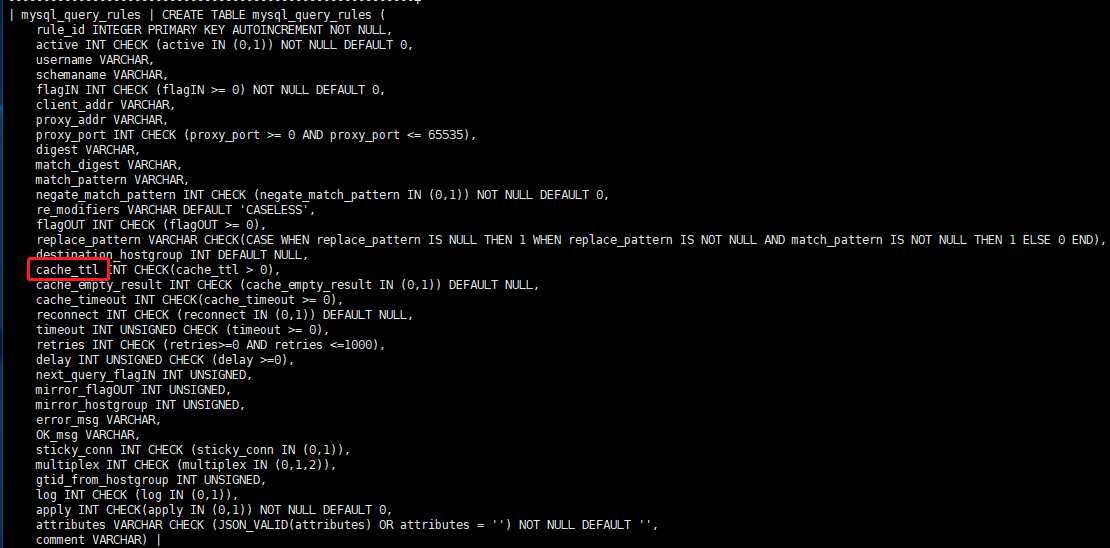

设置 cache_ttl 缓存时间
admin@localhost 10:21: [(none)]> update mysql_query_rules set cache_ttl=10000 where rule_id=2; Query OK, 1 row affected (0.00 sec)
load mysql query rules to runtime;
save mysql query rules to disk;
查看缓存
admin@localhost 10:33: [(none)]> select hostgroup, digest_text, digest, first_seen, last_seen, count_star from stats_mysql_query_digest order by count_star desc;
2. 利用proxysql 实现透明读写分离以及最佳实践
proxysql firewall
proxysql 审计
proxysql + MGR 使用
mysql router 与 proxysql 对比
mysql router 提供MGR的高可用, 节点故障自动处理
只能提供基于端口号的读写分离
proxysql: 功能丰富的中间件
更丰富的sql 路由规则, 更丰富的sql控制以及监控分析方法.
1. MGR mysql8.0 集群
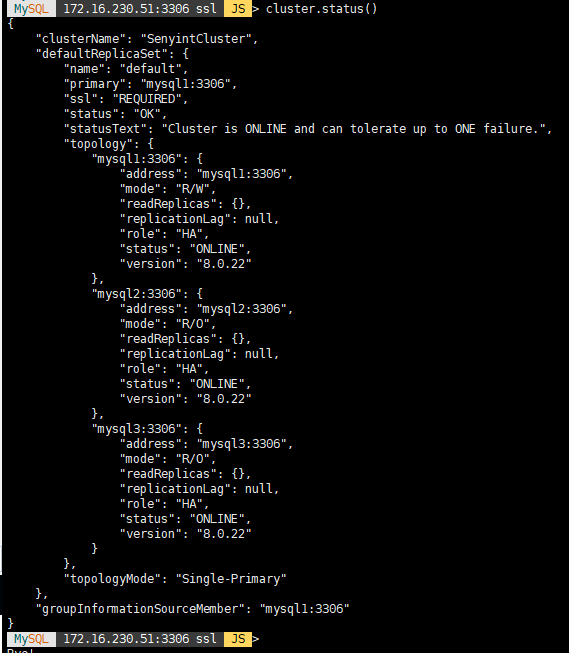
2. 初始化proxysql(好像不好用)
service proxysql-initial start
3. 在 mysql 主上 准备监控脚本
vim sys8_new.sql
USE sys; DELIMITER $$ CREATE FUNCTION my_id() RETURNS TEXT(36) DETERMINISTIC NO SQL RETURN (SELECT @@global.server_uuid as my_id);$$ CREATE FUNCTION gr_member_in_primary_partition() RETURNS VARCHAR(3) DETERMINISTIC BEGIN RETURN (SELECT IF( MEMBER_STATE='ONLINE' AND ((SELECT COUNT(*) FROM performance_schema.replication_group_members WHERE MEMBER_STATE NOT IN ('ONLINE', 'RECOVERING')) >= ((SELECT COUNT(*) FROM performance_schema.replication_group_members)/2) = 0), 'YES', 'NO' ) FROM performance_schema.replication_group_members JOIN performance_schema.replication_group_member_stats USING(member_id) where member_id=my_id()); END$$ CREATE VIEW gr_member_routing_candidate_status AS SELECT sys.gr_member_in_primary_partition() as viable_candidate, IF( (SELECT (SELECT GROUP_CONCAT(variable_value) FROM performance_schema.global_variables WHERE variable_name IN ('read_only', 'super_read_only')) != 'OFF,OFF'), 'YES', 'NO') as read_only, Count_Transactions_Remote_In_Applier_Queue as transactions_behind, Count_Transactions_in_queue as 'transactions_to_cert' from performance_schema.replication_group_member_stats where member_id=my_id();$$ DELIMITER ;
查看各个节点状态:
mysql1 主节点, read_only 为NO

mysql2 只读节点

mysql3 只读节点

4 . 创建账号: mysql主上创建程序链接账号
create user 'feng'@'%' identified with mysql_native_password by '123456'; grant all on *.* to 'feng'@'%'; create user 'monitor'@'%' identified with mysql_native_password by '123456'; grant replication client,select on *.* to 'monitor'@'%'; grant select on sys.* to 'monitor'@'%';
5. 登陆proxysql
[root@proxysql ~]# mysql -h 127.0.0.1 -P 6032 -u admin -padmin
6. 配置proxysql mysql_group_replication_hostgroups 建立分组

insert into mysql_group_replication_hostgroups(writer_hostgroup,backup_writer_hostgroup,reader_hostgroup,offline_hostgroup,max_writers)
values(100,200,300,400,1);
注释:
#该组中用于写操作的分组ID, 一般也是mysql_users中指定为用户的默认节点, 且要求read_only=0
writer_hostgroup : 100
#组中如果有多个 read_only=0 的节点, 其他成员放置的节点
backup_writer_hostgroup : 200
# 该组用户只读组
reader_hostgroup: 300
# 该组为离线组
offline_hostgroup: 400
#设置最多几个成员可以writer_hostgroup中
max_writers: 1
#写组成员是否担任读的工作
writer_is_also_reader
#节点事物延迟情况
max_transactions_behind
7. 添加用户名密码 使用 proxysql mysql_users
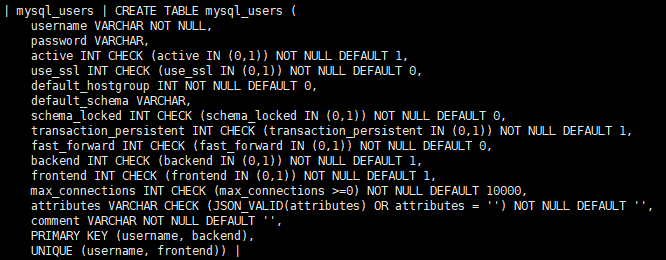
admin@localhost 17:43: [(none)]> insert into mysql_users(username,password,active,default_hostgroup,max_connections)
values('feng','123456',1,100,1000);

8.配置后端数据库地址 使用 proxysql mysql_servers
#插入集群的各节点地址,HG=100代表 backup_writer_hostgroup,后期通过自动检测让其自动再分配组。

admin@localhost 17:47: [(none)]> insert into mysql_servers(hostgroup_id,hostname,port,max_connections)
values(400,'172.16.230.51',3306,1000),(400,'172.16.230.52',3306,1000),(400,'172.16.230.53',3306,1000);

9. 修改监控用户名
#set mysql-monitor_username='mon'; #load mysql variables to run; # save mysql variables to disk;
10. 保存配置
load mysql users to runtime;
load mysql servers to runtime;
save mysql users to disk;
save mysql servers to disk;
11. 配置读写分离
INSERT INTO mysql_query_rules(rule_id,active,match_digest,destination_hostgroup,apply) VALUES(101,1,'^SELECT.*FOR UPDATE$',100,1),(102,1,'^SELECT',300,1);
LOAD MYSQL QUERY RULES TO RUNTIME;
SAVE MYSQL QUERY RULES TO DISK;

12. proxysql上校验:
select * from mysql_server_read_only_log;
select * from mysql_server_connect_log;
select * from mysql_server_ping_log;
13. 检查分组
select * from runtime_mysql_servers;

14. proxysql测试
mysql -h 172.16.230.54 -P 6033 -u fengjian -p12345
#查询

#update

java JDBC 链接mysql
jdbc:mysql//172.16.230.54:6033,172.16.230.55:6033,172.16.230.56:6033/fengjian?failOverReadOnly=false failOverReadOnly = true 连接第一个节点 write/read failOverReadOnly = false 所有节点都是: write/read
读写分离
https://dev.mysql.com/doc/connector-j/8.0/en/connector-j-source-replica-replication-connection.html
三. proxysql 可以提供的有可用的metric
官方文档:
https://proxysql.com/Documentation/


